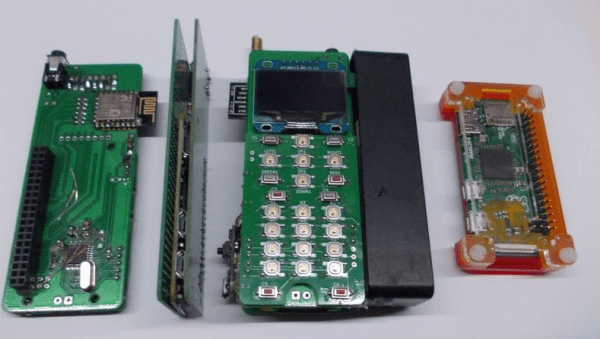The Hackaday Prize is a challenge to create hardware, and the ZeroPhone is quite possibly the most popular project entered in the Hackaday Prize. What is it? It’s a mobile phone built around the Raspberry Pi Zero that can be assembled for about $50 in parts. Already, it’s a finalist in the Hackaday Prize best product competition, a finalist for the grand prize of $50,000, and one of the most popular projects on Hackaday.io of all time.
We took a look at the ZeroPhone early this year, and while there have been significant advances in this project, the philosophy is still pretty much the same. This is a mobile phone with a numeric keypad and a 128 x 64 pixel OLED display — basically the same user interface as a Nokia brick. The brain of the phone is a Raspberry Pi Zero wrapped in a PCB sandwich, with options for WiFi, Bluetooth, HDMI and audio outputs, a USB port, battery charging, and a ton of GPIOs that include ISM band radios, infrared receivers and transmitters, more flash storage, and anything else you can imagine. Basically, we’re looking at one of those modular, reconfigurable smartphone ideas, using a Raspberry Pi as the brains. Tech journos should be creaming themselves over this. We’re looking forward to [Arsenijs]’ cover story in Wired.
As with any Open Source / DIY cell phone, the big question surrounding the ZeroPhone is the cellular radio. 2G radios are cheap and plentiful, but the infrastructure is either coming down shortly, or already is down. A 3G radio is a must for a minimum viable product, and [Arsenijs] says there are provisions for replacing the 2G radio with a 3G module. Of course, 3G modules aren’t as capital-‘O’-Open as their technological predecessors, but that’s a discussion for another time.
Already the ZeroPhone is a huge success. There’s an actual team working on this project, the ZeroPhone subreddit is bigger than the Hackaday subreddit, there are newsletters, a wiki, and there will be a crowdfunding campaign ‘shortly’. This is one to look out for, and a very worthy project in the running for the 2017 Hackaday Prize.
















